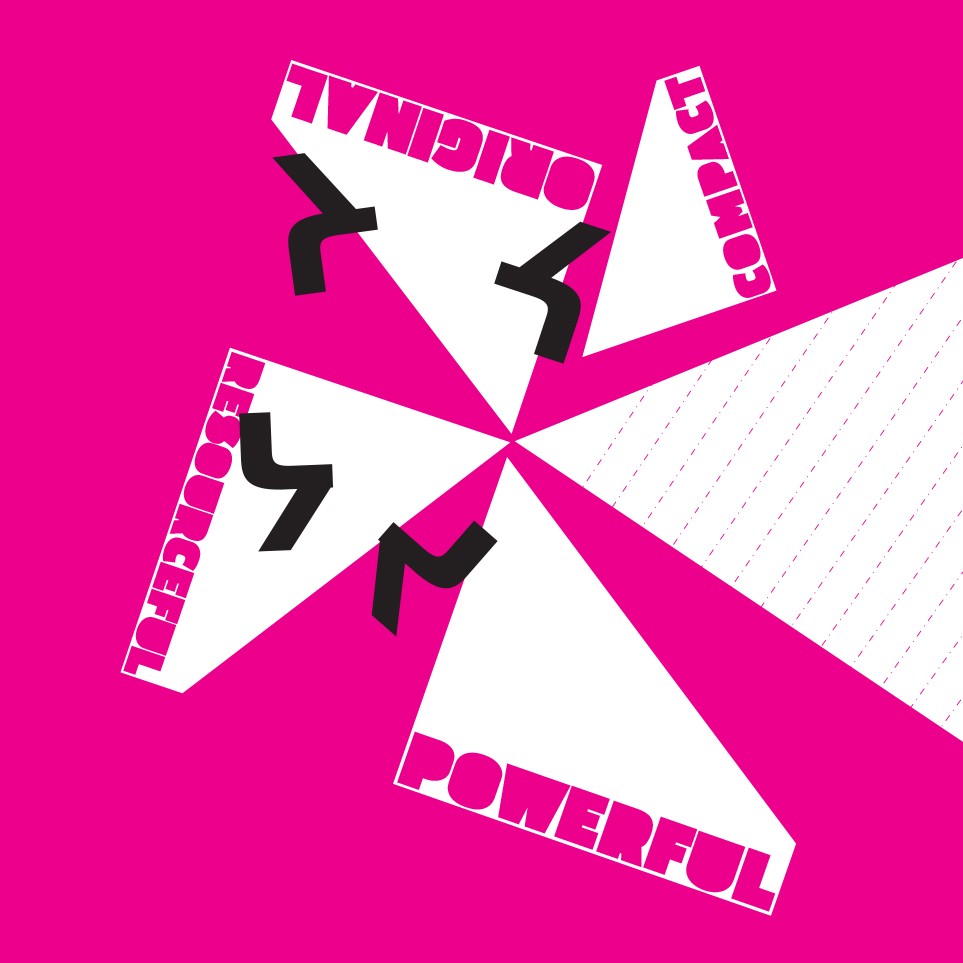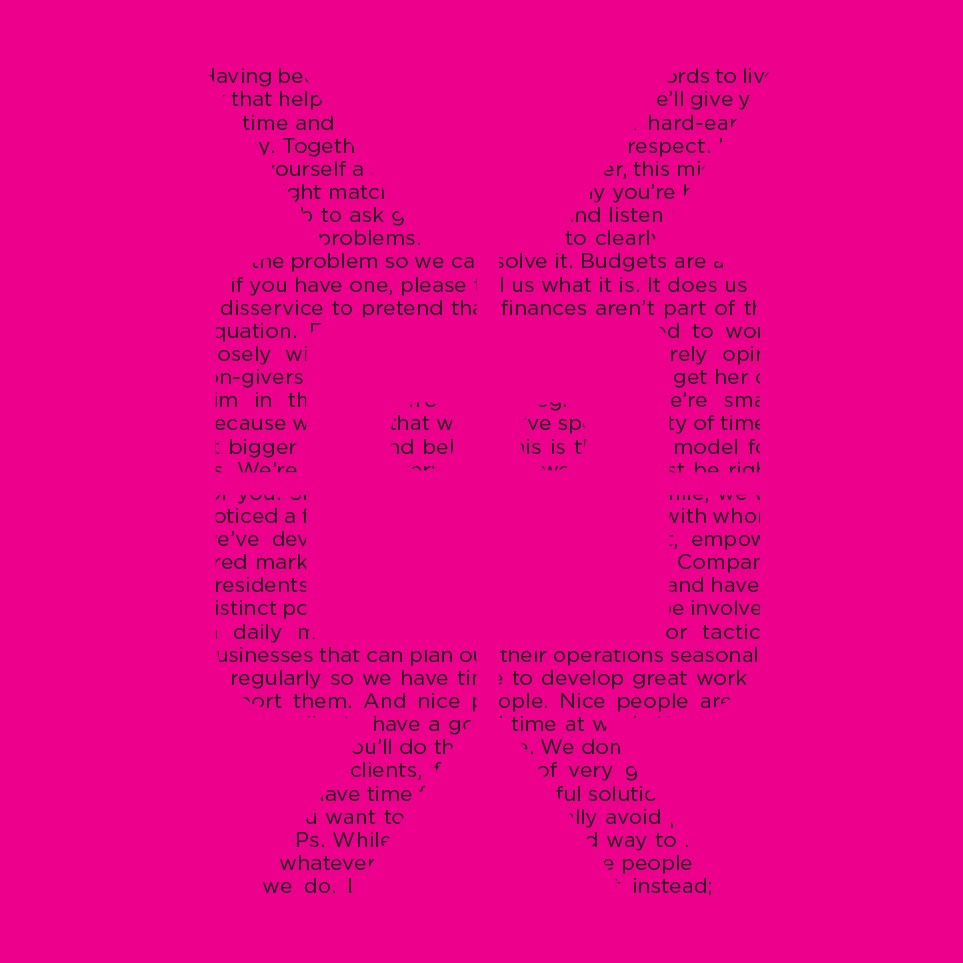We believe that if you’re going to interrupt someone’s life with a piece of communication, you’d better be sure that you reward them for paying attention: Make it fun. Make it real. Make it impactful. Make it informative. Make it smart. Make it emotional. Make it entertaining. Make it useful. Make it memorable. Just be sure not to waste their time. To get there, we dig in with our clients and work collaboratively to find the best solution to the task at hand. Every project is different, but this is generally how things go:
Step 1: Organization
Contracts get signed. Schedules get built. Deposits get paid. Budgets get finalized. Yada, yada, yada. It’s not sexy, but you get the picture. Timeframe: Not long.
Step 2: Inquisition
With Step 1 safely out of the way, we get down to work. Generally, this phase consists of asking lots of questions. We want to know what makes a client’s business, and its people, tick. Depending on budget, timing, existing research, and organizational consensus, this can be as simple as a conversation or as robust as a formal research project where we interview dozens of people. Timeframe: Anywhere from a few weeks to a few months.
Step 3: Collaboration
Now that discovery is complete, we can put together a work plan, which lays out key ingredients, like audience, tone, main message, opportunities/obstacles, and more. Ideally, it’s a one-pager that makes sure everyone’s in agreement and also serves as our creative inspiration for the project. Timeframe: Not long.
Step 4: Procrastination
If a problem doesn’t see us sneaking up on it, it can’t go running off into the woods to hide. Despite implications of laziness, this is an important part of the process. Timeframe: Not nearly as long as we’d like. There’s work to do, after all.
Step 5: Inferiority
This is generally what we refer to as the “we suck” phase of creative development. It involves jotting down a bunch of ideas that, when reviewed later, make little to no sense. This phase also involves a healthy dose of us doubting our own abilities, as well as questioning our career path and our general worth to humankind. Timeframe: Mercifully brief.
Step 6: Concept Creation
We really believe in the importance of coming up with an overarching concept, or “big idea,” for each of our clients, and then developing specific executions (ads, a website, collateral, videos, etc.) that bring it to life. Concept development involves a lot of time writing in sketchbooks, kicking around ideas, and just seeing where the story wants to take us. When it’s ready, we’ll share a small handful of initial ideas with a client, and then refine one based on their feedback and gut reactions. A great concept is one that tells a client’s story in an emotional way, and that leaves enough elbow room to come up with unique executions for the long term. Timeframe: As long as it takes to come up with something great.
Step 7: Doing the Doing
With a concept in place, we can bring it to life everywhere a client’s audience will experience the brand. In time, one should be able to lay out everything we do for a client and see a consistent and compelling story play out across all media: web, video, packaging design, ads, print, logo and identity, collateral, posters, etc. Timeframe: Ongoing.
Step 8: Cocktails
While our business is most overtly about creativity, relationships are equally important. We pride ourselves on our long-term connections with our clients. Almost all of our relationships started with a project and grew from there. Many clients are now friends, which makes drinks after a successful project all the more tasty. Timeframe: Early + often.
Step 1: Organization
Contracts get signed. Schedules get built. Deposits get paid. Budgets get finalized. Yada, yada, yada. It’s not sexy, but you get the picture. Timeframe: Not long.
Step 2: Inquisition
With Step 1 safely out of the way, we get down to work. Generally, this phase consists of asking lots of questions. We want to know what makes a client’s business, and its people, tick. Depending on budget, timing, existing research, and organizational consensus, this can be as simple as a conversation or as robust as a formal research project where we interview dozens of people. Timeframe: Anywhere from a few weeks to a few months.
Step 3: Collaboration
Now that discovery is complete, we can put together a work plan, which lays out key ingredients, like audience, tone, main message, opportunities/obstacles, and more. Ideally, it’s a one-pager that makes sure everyone’s in agreement and also serves as our creative inspiration for the project. Timeframe: Not long.
Step 4: Procrastination
If a problem doesn’t see us sneaking up on it, it can’t go running off into the woods to hide. Despite implications of laziness, this is an important part of the process. Timeframe: Not nearly as long as we’d like. There’s work to do, after all.
Step 5: Inferiority
This is generally what we refer to as the “we suck” phase of creative development. It involves jotting down a bunch of ideas that, when reviewed later, make little to no sense. This phase also involves a healthy dose of us doubting our own abilities, as well as questioning our career path and our general worth to humankind. Timeframe: Mercifully brief.
Step 6: Concept Creation
We really believe in the importance of coming up with an overarching concept, or “big idea,” for each of our clients, and then developing specific executions (ads, a website, collateral, videos, etc.) that bring it to life. Concept development involves a lot of time writing in sketchbooks, kicking around ideas, and just seeing where the story wants to take us. When it’s ready, we’ll share a small handful of initial ideas with a client, and then refine one based on their feedback and gut reactions. A great concept is one that tells a client’s story in an emotional way, and that leaves enough elbow room to come up with unique executions for the long term. Timeframe: As long as it takes to come up with something great.
Step 7: Doing the Doing
With a concept in place, we can bring it to life everywhere a client’s audience will experience the brand. In time, one should be able to lay out everything we do for a client and see a consistent and compelling story play out across all media: web, video, packaging design, ads, print, logo and identity, collateral, posters, etc. Timeframe: Ongoing.
Step 8: Cocktails
While our business is most overtly about creativity, relationships are equally important. We pride ourselves on our long-term connections with our clients. Almost all of our relationships started with a project and grew from there. Many clients are now friends, which makes drinks after a successful project all the more tasty. Timeframe: Early + often.


